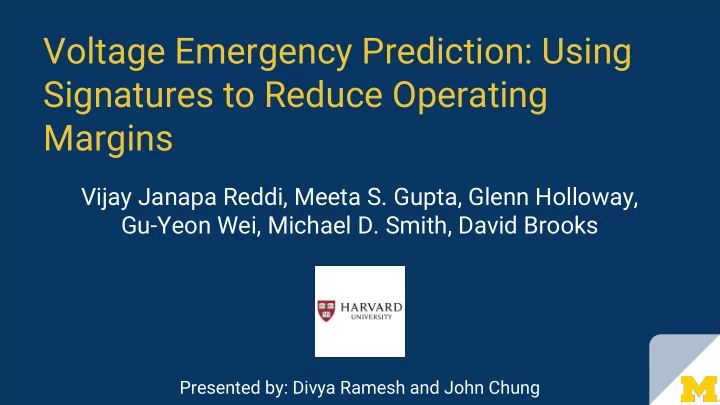

Voltage Emergency Prediction: Using Signatures to Reduce Operating Margins Vijay Janapa Reddi, Meeta S. Gupta, Glenn Holloway, Gu-Yeon Wei, Michael D. Smith, David Brooks Presented by: Divya Ramesh and John Chung 1
Why Do We Care? Feature size reduction => increased sensitivity to voltage fluctuations ● ● Voltage fluctuations cause timing issues and reduce transistor lifetimes Conservative operating margins lead to degraded performance ● ● Timing margins can be up to 20% of supply voltage 2
Proposed Solutions Voltage Emergency Prediction ● ● Signature-based Voltage Emergency Reduction Efficient Predictor Implementation ● 3
Previous Work and Limitations 4 Reddi, Vijay Janapa, et al. "Voltage emergency prediction: Using signatures to reduce operating margins." High Performance Computer Architecture, 2009. HPCA 2009. IEEE 15th International Symposium on . IEEE, 2009.
Goals Reddi, Vijay Janapa, et al. "Voltage emergency prediction: Using signatures to reduce operating margins." High Performance Computer Architecture, 2009. HPCA 2009. IEEE 15th International 5 Symposium on . IEEE, 2009.
A 10,000 FT View 6 Reddi, Vijay Janapa, et al. "Voltage emergency prediction: Using signatures to reduce operating margins." High Performance Computer Architecture, 2009. HPCA 2009. IEEE 15th International Symposium on . IEEE, 2009.
How Does it Work? I know nothing... 7 Reddi, Vijay Janapa, et al. "Voltage emergency prediction: Using signatures to reduce operating margins." High Performance Computer Architecture, 2009. HPCA 2009. IEEE 15th International Symposium on . IEEE, 2009.
How Does it Work? Emergency! I know nothing... 8 Reddi, Vijay Janapa, et al. "Voltage emergency prediction: Using signatures to reduce operating margins." High Performance Computer Architecture, 2009. HPCA 2009. IEEE 15th International Symposium on . IEEE, 2009.
How Does it Work? Emergency! Recover, Resume execution Predictor needs to remember this moment... 9 Reddi, Vijay Janapa, et al. "Voltage emergency prediction: Using signatures to reduce operating margins." High Performance Computer Architecture, 2009. HPCA 2009. IEEE 15th International Symposium on . IEEE, 2009.
How Does it Work? Recover, Resume execution Predictor needs to Roger that! remember this moment... 10 Reddi, Vijay Janapa, et al. "Voltage emergency prediction: Using signatures to reduce operating margins." High Performance Computer Architecture, 2009. HPCA 2009. IEEE 15th International Symposium on . IEEE, 2009.
How Does it Work? Eme….! I can prevent it! 11 Reddi, Vijay Janapa, et al. "Voltage emergency prediction: Using signatures to reduce operating margins." High Performance Computer Architecture, 2009. HPCA 2009. IEEE 15th International Symposium on . IEEE, 2009.
What Does the Predictor Need to Know? Flush in 2 causes an emergency sometimes, but does not other times. 12 Reddi, Vijay Janapa, et al. "Voltage emergency prediction: Using signatures to reduce operating margins." High Performance Computer Architecture, 2009. HPCA 2009. IEEE 15th International Symposium on . IEEE, 2009.
What Does the Predictor Need to Know? Flush in 2 causes an emergency sometimes, but does not other times. Combination of contexts can signal the future emergency! 13 Reddi, Vijay Janapa, et al. "Voltage emergency prediction: Using signatures to reduce operating margins." High Performance Computer Architecture, 2009. HPCA 2009. IEEE 15th International Symposium on . IEEE, 2009.
Flush in 2 sometimes causes emergency, but sometimes does not Voltage emergencies are quite repetitive and → Combination of contexts stable thus enabling their PREDICTION! can signal the future emergency! 14
How Do We Get Predictions? ● Predict possible emergencies from event history register Capture interleaved sequence of control flow instructions and architectural ● events that give rise to an emergency 15 Reddi, Vijay Janapa, et al. "Voltage emergency prediction: Using signatures to reduce operating margins." High Performance Computer Architecture, 2009. HPCA 2009. IEEE 15th International Symposium on . IEEE, 2009.
Contents of Signals for Prediction ● Program Control Flow : Out-of-Order Issue > In-order Fetch and Decode > In-order Commit Microarchitectural events increase the accuracy even more! ● 16 Reddi, Vijay Janapa, et al. "Voltage emergency prediction: Using signatures to reduce operating margins." High Performance Computer Architecture, 2009. HPCA 2009. IEEE 15th International Symposium on . IEEE, 2009.
Size of Entries for Prediction More entries => better accuracy. But, cost of prediction might get expensive! Signature size =4 17 Reddi, Vijay Janapa, et al. "Voltage emergency prediction: Using signatures to reduce operating margins." High Performance Computer Architecture, 2009. HPCA 2009. IEEE 15th International Symposium on . IEEE, 2009.
Hardware Overhead Reduction Signature encoding: 3 bit encoding + Anchor PC (the program counter for ● the most recently taken branch) ● Signature compaction: Measure similarity with Manhattan distance → compact signatures with similarity higher than 0.9 ○ 67% signature reduction for 403. gcc 18
Predictor Accuracy Evaluation 19 Reddi, Vijay Janapa, et al. "Voltage emergency prediction: Using signatures to reduce operating margins." High Performance Computer Architecture, 2009. HPCA 2009. IEEE 15th International Symposium on . IEEE, 2009.
Comparison of Schemes 20 Reddi, Vijay Janapa, et al. "Voltage emergency prediction: Using signatures to reduce operating margins." High Performance Computer Architecture, 2009. HPCA 2009. IEEE 15th International Symposium on . IEEE, 2009.
Discussion (1) Voltage emergency prediction suffers from cold-start problem, which requires that the chip to first experience emergency before the predictor can learn predictions. Is the cold-start problem be trivial, with no need to be cared? ● ● Can we pre-train the predictor to avoid cold-start problem? 21
Discussion (2) Compare checkpoint recovery schemes with prediction-based throttling schemes. What are some of the advantages and disadvantages of each approach? ● 22
Discussion (3) Does the velocity of voltage drop matter? ● Does voltage drop differ between different types of emergencies? ● Can this technique consider the velocity of the voltage drop? 23
Recommend
More recommend